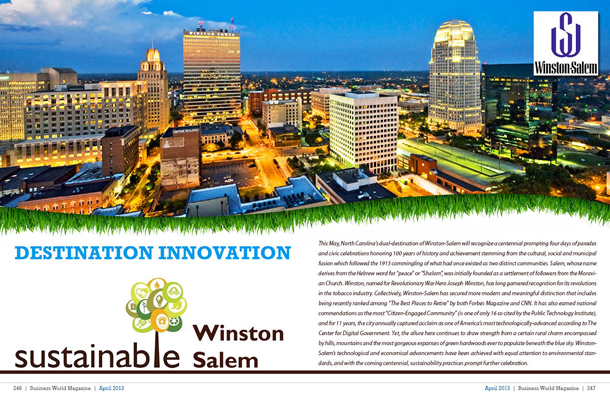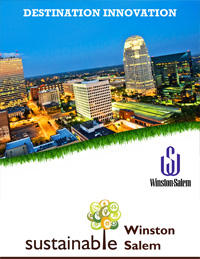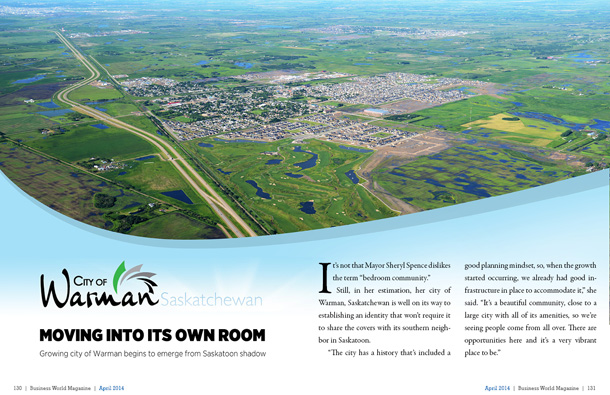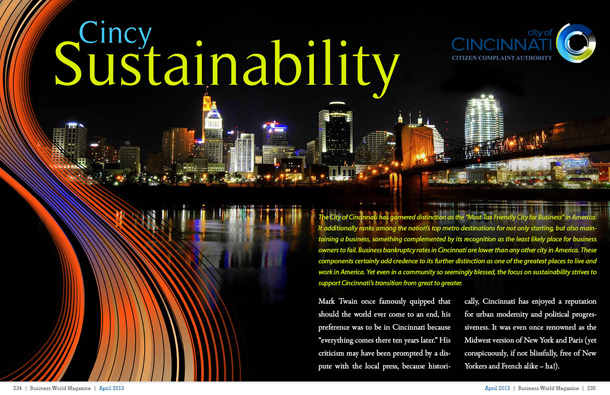
Destination Innovation

This May, North Carolina’s dual-destination of Winston-Salem will recognize a centennial prompting four days of parades and civic celebrations honoring 100 years of history and achievement stemming from the cultural, social and municipal fusion which followed the 1913 commingling of what had once existed as two distinct communities. Salem, whose name derives from the Hebrew word for “peace†or “Shalomâ€, was initially founded as a settlement of followers from the Moravian Church. Winston, named for Revolutionary War Hero Joseph Winston, has long garnered recognition for its revolutions in the tobacco industry. Collectively, Winston-Salem has secured more modern and meaningful distinction that includes being recently ranked among “The Best Places to Retire†by both Forbes Magazine and CNN. It has also earned national commendations as the most “Citizen-Engaged Community†(is one of only 16 so cited by the Public Technology Institute), and for 11 years, the city annually captured acclaim as one of America’s most technologically-advanced according to The Center for Digital Government. Yet, the allure here continues to draw strength from a certain rural charm encompassed by hills, mountains and the most gorgeous expanses of green hardwoods ever to populate beneath the blue sky. Winston-Salem’s technological and economical advancements have been achieved with equal attention to environmental standards, and with the coming centennial, sustainability practices prompt further celebration.
In terms of important dates, February 16, 2005, could arguably represent a watershed moment in the history of Winston-Salem. On that day, more than 141 nations throughout the world came together pledging commitment to curb human factors contributing to climate change and global warming by ratifying an agreement known as the Kyoto Protocol. In a move that compelled considerable consternation at the time, the United States refused to participate. The inaction was baffling to some considering findings that U.S. greenhouse gas emissions represented 25% of all on Earth even though it doesn’t come close to representing 25% of the world’s population. The issue was particularly perplexing to town and city mayors throughout America and following a campaign led by a Mayor Greg Nickels of Seattle, a resolution was adopted during that year’s US Conference of Mayors. Known as the US Mayors Climate Protection Agreement, the idea was that mayors could adopt the kind of environmental practices advocated by the Kyoto Protocol and through their collective efforts to reduce carbon emissions; they would accomplish what the federal government would not.
Winston-Salem Mayor Allen Joines was among those who pledged support of the agreement. In the years that have followed since his commitment to this environmental initiative, numerous changes have occurred in Winston-Salem, in degrees both visible and not-so-visible, but in either case, there can be no disputing that air and water quality has improved, understanding of sustainability practices have increased, greener spaces have been grown along with jobs involving greening, and all those efforts have additionally led to more green in terms of cost savings. For his part, Mayor Joines is quick to credit City Council, City Staff as well as the community of residents and professional enterprises which have adopted green practices in their respective departments, homes and operational bases. “The City has set the tone for the community by saying, ‘Look, we care about our environment,’ and we’ve looked to them to be part of it and they have,†says Mayor Joines.
To put that in proper context, upon his signing of the Climate Protection Agreement, Mayor Joines, with approval of the city council, established an advisory committee comprised by a broad-based collective of city staff and business as well as community leaders who all had mutual interest in environmental issues.
They began by establishing baseline data involving energy usage, water consumption, emissions and more. In order to monitor the results they might achieve, there had to be a measurement of where they were at that moment. “My philosophy is you have to document what you’re doing. It’s not enough to just talk about doing something to feel good… there had to be data to be demonstrative in what we’re trying to achieve.
Their efforts coalesced with the securing of federal grants associated with stimulus strategies. The city directed a portion of those funds to improve city buildings and fleet operations, but also determined to hire someone with oversight of all their sustainability activities and Wendell Hardin was appointed as Winston-Salem’s Sustainability Director. Hardin was a former City Planner in Prescott, Arizona. In Arizona, Hardin had helped coordinate that community’s focus on sustainability processes, securing significant achievements which included a 25% reduction in water usage which was a very big deal in this very dry area of the country.
Of course, Winston-Salem isn’t afflicted with such water shortages, nor does it suffer from the degree of atmospheric degradation that hovers over some city skylines. The environmental deficiencies that plague some communities, which compel certain urgency to adopt sustainability practices, simply weren’t an issue in Winston-Salem. According to Sustainability Director Hardin, Winston-Salem city operations only constitute about two percent of the total green house gasses emitted in Forsyth County. With such as the case, Hardin says the city’s advancements are a byproduct of the proactive vision of Mayor Joines and the city council. “They saw what was happening around the world and said, ‘We need to be part of it, or be ahead of it.’ They made sustainability a focus and determined to move forward and make changes in our city,†he says.
At present, city staff is intently studying data to allow for comprehensive reporting, yet they have already identified some major benefits resulting from their sustainability initiative. For example, after making lighting retrofits in city buildings and converting city streetlights to L.E.D. systems, utility rates that had averaged $113,000 annually have now been reduced by $30,000. That also equates to reducing green house gases by more than 380 tons a year. Changes in residential waste collection have led also led to greater recycling. In equipping residents with larger containers and moving collection to once a week, the community has helped curb fuel usage for collection, but has also seen a 25% increase in materials being recycled which means less going into area landfills. Ordinances involving runoff from agriculture/farming has also led to improved water quality of area streams and waterways. And through the updating of pumps in municipal systems, the community has reduced water consumption by almost 20 percent. Collectively, despite growth in the community, efforts have lowered green house gas emissions to levels similar to that which existed more than eight years ago.
Building Buy-In
Hardin say implementing sustainable practices quite often comes down to effect behavioral change. As much as the community administration knew they would have to lead by example, their strategy also involved educating residents and business owners about things they could do.
Early on, Winston-Salem coordinated staging of one of the largest green expositions ever to be conducted, an event that included workshops and informational booths that filled some 200,000 square feet of space at their convention center. The city also staged workshops throughout residential neighborhoods, yet went even a step further by using grant funds to go directly into people’s homes and provide free audits that assessed areas where air might be escaping or entering through deficient door jams and/or windows. They also assessed how homeowners were using lighting. In most cases, the weatherization improvements were minor, but even small adjustment can lead to big savings in utility consumption. Volunteers with the local chapter of the U.S. Green Building Coalition actually helped in the process, and with the aid of grants, more than 125 homes benefitted from weatherization upgrades. The work was carried out by several area contracting firms, and in the case of one, Hardin notes that it saw so much work it has since determined to create a new company division that specifically focuses on weatherization services.
The city has also played a critical role in creating two area organizations which are driving further practices in sustainability. Through the work of Keep Winston-Salem Beautiful, area schools are becoming more green-friendly. In addition to hosting various workshops at schools, the organization rates results achieved by each school and honors best practices during an annual recognition ceremony. Another organization is known as the Sustainability Resource Center, an endeavor which has a broad community outreach and is currently engaged in efforts relating to the growth of bike paths and community gardens.
Winston-Salem is currently reviewing strategies to expand bike paths and grow community gardens on abandoned lots in urban areas, initiatives largely prompted by resident advocacy. Greater shades of green are also evidenced through the city’s annual planting of several hundred new trees which not only add to the beauty, but also play a fundamental role in the sequestering of carbon from the atmosphere. Hardin says those trees “are the lifeblood of our community and they work hard for us every day.â€
Of course, there is a lot of work taking place every day in Winston-Salem and Mayor Joines is quick to acknowledge how critical job creation and economic stability is to city sustainability efforts. The city recently negotiated a deal which kept tech giant Inmar’s operational headquarters in Winston-Salem. A provider of technology networks and platforms for the processing of financial transactions as well as supply chain solutions critical to national retailers and manufacturers, Inmar was almost recruited away and the community would have lost some 1,000 jobs. Other major job creators in Winston-Salem include an industry giant in the manufacturing of “gentlemen preferred†hosiery and other apparel, the Hanes Company. Caterpillar also recently decided to locate a new manufacturing facility here, a development valued at more than $425 million. For more than 20 years, downtown Winston-Salem has also been home to one of the nation’s largest hubs of research involving biomedical engineering, regenerative medicine and information technology. Formerly known as the Piedmont Triad Research Park, the area has been rebranded as “Wake Forest Innovation Quarter†to better recognize the role of the university so critical to its creation.
Mayor Joines says sustainability practices have been adopted by all of these industry players. He credits Hanes Company and Duke Energy for being significant sponsors in events such as the Green Exposition hosted by Winston Salem. He also recognized how Hanes has added solar power energy systems to augment efficiencies of their facility, and some two-thirds of buildings at their site have achieved LEED certification. Caterpillar, he additionally notes, is also on its way of achieving gold level LEED certification in the construction of their new manufacturing plant. In expanding development of the Wake Forest Innovation Quarter, principals were able to recycle materials from older construction and concrete for the building of new roads and buildings, with many of those structures also achieving LEED certification.
Mayor Joines says the Wake Forest Innovation Quarter is already one of the largest urban research parks in the country, but it is now one of the fastest growing in country. He says the work of that area is vital to bolstering the “knowledge based†segment of the community’s economic model. “We are working hard and I think we are starting to get some traction in creating a culture of innovation and rapid change… successful cities of the future will have to embrace innovation and change, and my passion is creating that for our city,†says Mayor Joines.
The focus on sustainability is far from complete and Director Hardin indicates other projects are in-the-works while strategies for increased sustainability practices are also being formulated with county and regional forces. Hardin says strategies will likely lead to improvements in the prevention of erosion, further improvement to area waterways, improved efficiency in area transit systems and further enhancements to existing area greenways. At the end of the day, Hardin says the work that has been undertaken has not only helped the community to become more efficient and save money, but has more importantly improved air quality and ecological factors in such a way as to improve the health of area residents. As Hardin says, “We care about the environment and the health of our residents and we’re doing all that we can to make this a more livable community.â€
Livability is already backed-up by some important factors which include the moderate climate, the low cost of living, median home prices of $129,000, the presence of universities and colleges, and the significant composite of doctors per capita. Such nuances serve in Winston-Salem’s ranking on the Milken Institute’s list of “Best Cities for Successful Aging.â€
Yet, in terms of Winston-Salem’s ability to attract future families as well as new business, sustainability is integral to the strategy. Mayor Joines says studies show that young entrepreneurs and industry leaders positioned among that branded as “the creative class†are especially drawn to areas enriched by diversity and respect for the environment. He believes that sustainability is not only adding the fiscal efficiency and future economic prosperity of Winston-Salem, but is adding greater quality to the lives of everyone there today. As sustainability practices will add to all that can be celebrated in the community’s upcoming centennial, Mayor Joines says such focus will continue to be fundamental to Winston-Salem’s future.
For more information, please visit their website at: Â City of Winston-Salem
Preferred Vendor of Choice:








